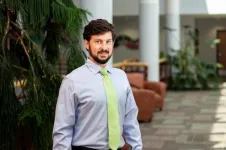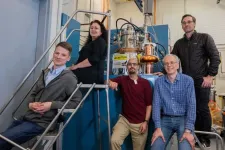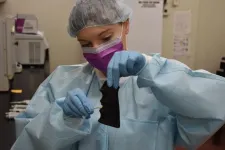(Press-News.org) Cell division is the generative spark of nearly every lifeform on Earth. But if healthy growth goes unchecked, cell division can turn lethal, overwhelming the organism. Such is the case with so-called oncogenes. When altered by a mutation, these growth-moderating genes go haywire, producing a geyser of cancer cells as a result. Oncogenes are also insidiously adept at generating tumors that over time become genetically “independent” from their origin, so it has been exceedingly difficult for scientists to shut down their replication at the source.
Now Rockefeller University researchers have discovered a new way to target the oncogene behind a rare and often deadly liver disease using small interfering RNAs (siRNAs), an innate mechanism for silencing gene expression. As described in Molecular Therapy, the researchers slipped siRNAs inside fibrolamellar hepatocellular carcinoma (FLC) cells through a surface receptor, where they blocked the oncogene from producing illness-inducing proteins that lead to tumor formation.
It’s the first time that siRNAs have been used to hobble the progression of FLC, says first author Christoph Neumayer, a Ph.D. student in Rockefeller’s Laboratory of Cellular Biophysics, headed by Sanford M. Simon.
But the findings have wider applications as well. “That’s the really exciting part,” says Neumayer. “This is proof of concept that siRNAs can be used for FLC, as well as adult liver cancers, which are much more common, and other tumor types elsewhere in the body.”
The fusion oncogene
FLC is caused by the fusion of two genes located on chromosome 19: DNAJB1, which produces heat-shock proteins that encourage cell homeostasis, and PRKACA, which produces an enzyme called kinase A that’s key to cellular metabolic function. The resulting fusion, known as DNAJB1::PRKACA, brings together the proteins and a catalytic subunit of the kinase. This dysfunctional union promotes FLC formation, but how, exactly, is still unknown.
Researchers in Simon’s lab discovered that this fusion caused FLC in 2014, several years after Simon’s own teenage daughter, Elana, was diagnosed with liver disease. After having the resulting tumor removed—the only treatment option available to people with FLC—Elana went on to collaborate with her father to unearth its cause, publishing the results in Science.
Since then, Simon and his group have continued to reveal the mechanisms behind the disease as well as develop therapeutics. The siRNA research is part of a three-part strategy which also includes repurposing drugs for treating FLC and using molecules known as PROTACs to selectively degrade the DNAJB1::PRKACA protein that drives FLC. The drug repurposing is in advanced preparation for a clinical trial, and some of the PROTAC work is part of an international collaboration that was just awarded a $25 million Cancer Grand Challenges grant to develop treatments for high-risk, oncogene-driven cancers in children.
Recently, Simon’s lab discovered that they could completely stop FLC tumor growth in mice using shRNAs, short sequences of RNA that can be engineered to disrupt mRNA. The approach also caused many tumors to shrink or disappear.
Having shown that quelling the fused oncogene killed tumor cells, they decided to experiment with derailing kinase A activity, which research indicated was driving tumor growth.
Unlocking the cell door
The problem was, fused kinase A and its “wild type” form are nearly identical, so “any drug you developed that blocks fused kinase A activity would affect all kinase A, including in normal cells,” Neumayer says. “In other words, you would incur a host of problematic side effects.”
They had to find a way to disable toxic kinase while containing the impact so that kinase in other cells weren’t affected. To do that, they specifically designed siRNAs to aim at the fusion. But because siRNAs cannot cross cell membranes, the researchers needed to figure out a way to get the siRNA inside.
Luckily, a door into the cell had already been identified: a receptor called ASGR1 that’s only expressed in liver cells. Its key had been too: a binding molecule known as GalNAc. Together, the duo function as a waste disposal team.
GalNAc conjugate therapies, which attach siRNA molecules to the ligand to deliver therapies inside cells, are already on the market for conditions such as hereditary transthyretin-mediated amyloidosis and atherosclerotic cardiovascular disease. The team wondered if they could use the same approach to thwart the kinase driving FLC tumors.
Stabilization and shrinkage
To test their theory, the researchers attached a custom siRNA to the receptor’s ligand and studied the method in a variety of tumor models in mice and in human cell cultures. The conjugate therapy was not only successfully delivered into the cells in all contexts, but it also caused a reduction of mRNA in the oncogene, preventing the production of the protein and resulting in the tumors stagnating or shrinking, unable to grow. They also did not detect any liver toxicity in the mice, indicating the animals tolerated the siRNAs well.
“What we saw was tumor inhibition, when we had hoped to outright kill the tumor,” Neumayer notes. “Our future direction will be to try to figure out how to improve that.”
They also tested the specificity of the siRNA by injecting it into tumor cells of another type of liver cancer. It had no toxic impact on them—exactly as the researchers hoped. “We wanted to show that our siRNA is so targeted to the FLC fusion oncogene that it has no side effects on other cells—even on other cancer cells,” he notes.
Neumayer says the findings suggest that siRNAs may be effective beyond FLC, capable of treating tumors throughout the body with a high degree of specificity: “I think siRNA medicines as a class will have a big impact over time as a new kind of genetic therapy.”
END
A pioneering way to target the culprit behind a deadly liver cancer
2024-03-14
ELSE PRESS RELEASES FROM THIS DATE:
Clay Wright receives MIRA funding to create new molecular tools
2024-03-14
Clay Wright, assistant professor in the College of Agriculture and Life Sciences’ Department of Biological Systems Engineering, was awarded a prestigious Maximizing Investigators' Research Award (MIRA) from the National Institute of General Medical Sciences, part of the National Institutes of Health.
The funding is aimed at providing the investigator, versus a specific project, enhanced stability and flexibility for further discovery, enhancing scientific productivity and the chances for significant breakthroughs outside the initial scope of the project.
This recognition supports Wright's innovative work in understanding ...
Shade-grown coffee demonstrates the benefits of combining agriculture and conservation, an Oxford Brookes University study reveals
2024-03-14
Increasing shade cover over coffee plants can increase biodiversity and provide new ways to combine agriculture and conservation, a new study has revealed.
Coffee grown in high shade, with more than 30% canopy cover, provides a home to more plant and animal species than coffee grown in the sun or on low shade farms with less than 30% canopy cover, the study found.
Preserving biodiversity is good news for farmers as it means better natural pest control, and improved soil ...
Mind the mask!
2024-03-14
Building on what was learnt to one's cost during the pandemic to improve health management in the future. This motivation has led scholars and researchers to take up the topic and investigate various aspects beyond the emergency phase.
Just recently, an article by the first signatory and corresponding author, Giuseppe Alessandro Veltri of the Department of Sociology and Social Research of the University of Trento, focused on the public health guidelines adopted during the pandemic. The research team assessed the effect perceived ...
Dr. Lawrence J. Rosenblum elected IEEE Fellow
2024-03-14
WASHINGTON – U.S. Naval Research Laboratory (NRL) researcher, Lawrence Rosenblum, Ph.D., was elevated to the prestigious grade of Fellow of The Institute of Electrical and Electronics Engineers (IEEE) in the class of 2024 for leadership in developing mobile augmented reality, visualization and visual analytics of complex data. Fellow is IEEE’s highest member grade and is awarded through a rigorous review process only to candidates with extraordinary accomplishments.
Rosenblum joined NRL’s Acoustics Division ...
New study on mating behaviors offers clues into the evolution of attraction
2024-03-14
Sparks fly when a female nematode meets her mate in a Petri dish. Tracking him by smell, she beelines over and is pregnant within moments of physical contact. But for the hermaphroditic version of these tiny roundworms, it’s a very different story. Anatomically female but capable of self-fertilizing with their own supply of sperm, hermaphrodites remain emphatically uninterested in mating—until their sperm supply runs dry. Only then will they seek out males.
Within such previously unknown details about microscopic mating rituals ...
Adapting particle accelerators for industrial work
2024-03-14
NEWPORT NEWS, VA – Superconducting radiofrequency (SRF) technology allows particle accelerators to efficiently produce powerful electron beams. Physicists use these beams to study the building blocks of matter at the U.S. Department of Energy’s Thomas Jefferson National Accelerator Facility. But these research machines also have a promising list of industrial applications. Now, some researchers are figuring out how to get SRF accelerators out of the lab and into industry.
One potential industrial use is in water treatment plants.
Per- and polyfluoroalkyl substances (PFAS) are present in many products, including certain non-stick cookware, water-resistant ...
One in five state Medicaid programs covers weight loss medications
2024-03-14
Mounting evidence suggests that FDA-approved weight loss medications, such as Wegovy, not only help patients lose weight but also protect against complications from obesity such as cardiovascular disease. In 2021, 40 percent of patients enrolled in Medicaid had obesity. The high cost of these drugs has raised concerns about affordability, both for patients and public insurance programs.
Researchers from Brigham and Women’s Hospital, a founding member of Mass General Brigham, studied state Medicaid coverage policies for anti-obesity medications from 2011 through the first quarter of 2023, finding that 10 out of 47 states covered at least ...
Aston University to shrink carbon footprint of industrial gas burners
2024-03-14
Aston University is working with an engineering company to make industrial gas burners less environmentally damaging
It has entered a knowledge transfer partnership (KTP) with Lanemark Combustion Engineering
A KTP is a three-way collaboration between a business, an academic partner and a highly qualified researcher.
Aston University is working with an engineering company to make industrial gas burners less environmentally damaging.
The University has entered a knowledge transfer partnership (KTP) with Lanemark Combustion Engineering to ...
Initial SARS-CoV-2 vaccinations prime immune cells to respond to subsequent variants
2024-03-14
PHILADELPHIA – Antibody responses to new SARS-CoV-2 variant infections and vaccinations are powerfully shaped by prior exposures to earlier SARS-CoV-2 vaccines, according to a new study from the Perelman School of Medicine at the University of Pennsylvania.
In the study, published today in Immunity, the researchers analyzed antibody responses in people infected with or vaccinated against the relatively new SARS-CoV-2 variants BA.5 and XBB. They found that even though BA.5 and XBB are very different from the original “ancestral” ...
New simpler and cost-effective forensics test helps identify touch DNA
2024-03-14
DURHAM, N.H.—Television dramas, like CSI and NCIS, make criminal investigations look easy. In real life, DNA testing can be challenging and requires expensive equipment, special facilities and extensive training to identify DNA from a crime scene and determine which belongs to a potential suspect and which may have been transferred from someone who was never there. Research from the University of New Hampshire has found a less expensive and easier to use test to learn more about forensic touch DNA. This research has important implications for forensic investigations and ...





